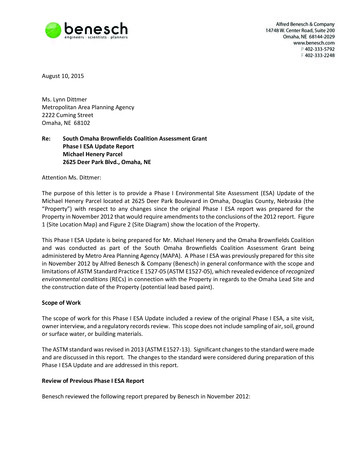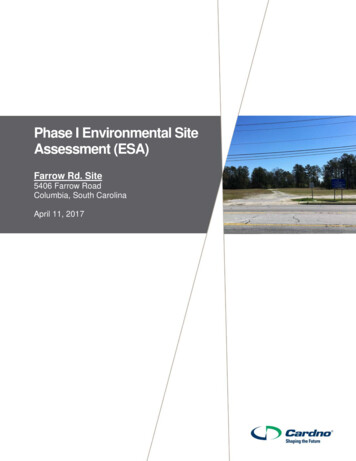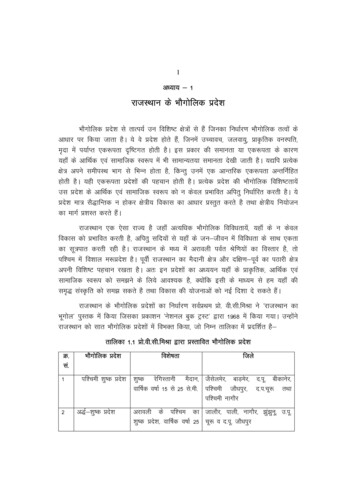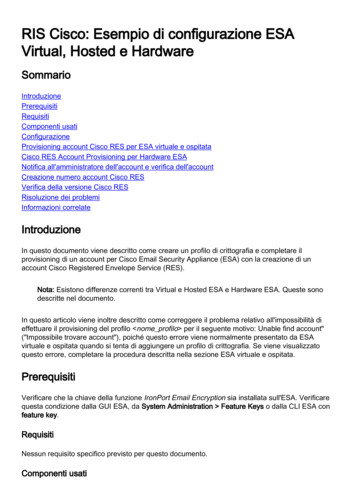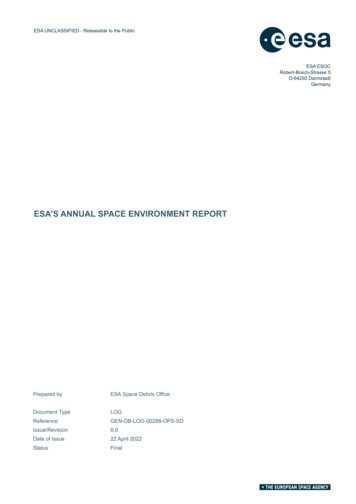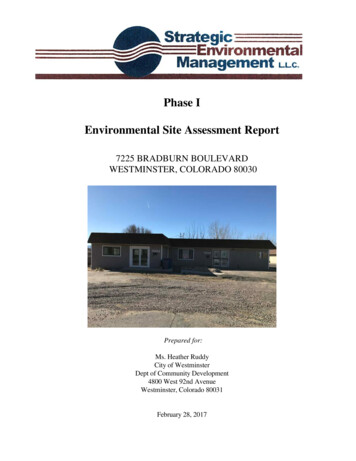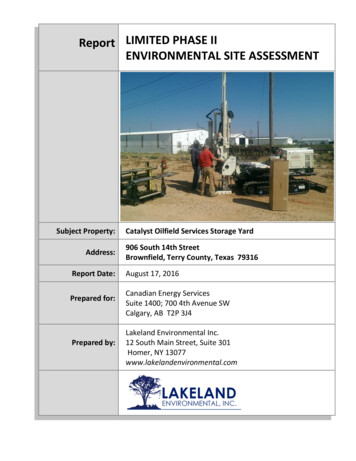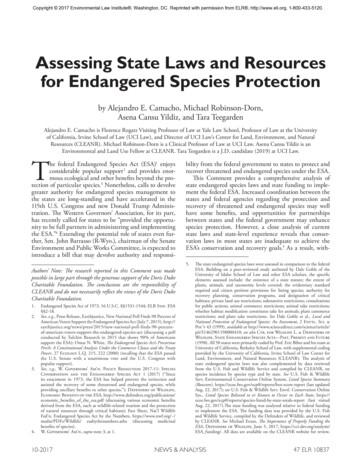
Transcription
Copyright 2017 Environmental Law Institute , Washington, DC. Reprinted with permission from ELR , http://www.eli.org, 1-800-433-5120.Assessing State Laws and Resourcesfor Endangered Species Protectionby Alejandro E. Camacho, Michael Robinson-Dorn,Asena Cansu Yildiz, and Tara TeegardenAlejandro E. Camacho is Florence Rogatz Visiting Professor of Law at Yale Law School, Professor of Law at the Universityof California, Irvine School of Law (UCI Law), and Director of UCI Law’s Center for Land, Environment, and NaturalResources (CLEANR). Michael Robinson-Dorn is a Clinical Professor of Law at UCI Law. Asena Cansu Yildiz is anEnvironmental and Land Use Fellow at CLEANR. Tara Teegarden is a J.D. candidate (2019) at UCI Law.The federal Endangered Species Act (ESA)1 enjoysconsiderable popular support2 and provides enormous ecological and other benefits beyond the protection of particular species.3 Nonetheless, calls to devolvegreater authority for endangered species management tothe states are long-standing and have accelerated in the115th U.S. Congress and new Donald Trump Administration. The Western Governors’ Association, for its part,has recently called for states to be “provided the opportunity to be full partners in administering and implementingthe ESA.”4 Extending the potential role of states even further, Sen. John Barrasso (R-Wyo.), chairman of the SenateEnvironment and Public Works Committee, is expected tointroduce a bill that may devolve authority and responsi-bility from the federal government to states to protect andrecover threatened and endangered species under the ESA.This Comment provides a comprehensive analysis ofstate endangered species laws and state funding to implement the federal ESA. Increased coordination between thestates and federal agencies regarding the protection andrecovery of threatened and endangered species may wellhave some benefits, and opportunities for partnershipsbetween states and the federal government may enhancespecies protection. However, a close analysis of currentstate laws and state-level experience reveals that conservation laws in most states are inadequate to achieve theESA’s conservation and recovery goals.5 As a result, with5.Authors’ Note: The research reported in this Comment was madepossible in large part through the generous support of the Doris DukeCharitable Foundation. The conclusions are the responsibility ofCLEANR and do not necessarily reflect the views of the Doris DukeCharitable Foundation.1.Endangered Species Act of 1973, 16 U.S.C. §§1531-1544; ELR Stat. ESA§§2-18.2. See, e.g., Press Release, Earthjustice, New National Poll Finds 90 Percent ofAmerican Voters Support the Endangered Species Act (July 7, 2015), -the-endangered-species-act (discussing a pollconducted by Tulchin Research in 2015 that shows 90% of Americanssupport the ESA); Omar N. White, The Endangered Species Act’s PrecariousPerch: A Constitutional Analysis Under the Commerce Clause and the TreatyPower, 27 Ecology L.Q. 215, 222 (2000) (recalling that the ESA passedthe U.S. Senate with a unanimous vote and the U.S. Congress withpopular support).3. See, e.g., W. Governors’ Ass’n, Policy Resolution 2017-11: SpeciesConservation and the Endangered Species Act 1 (2017) (“Sinceits enactment in 1973, the ESA has helped prevent the extinction andassisted the recovery of some threatened and endangered species, whileproviding ancillary benefits to other species.”); Defenders of Wildlife,Economic Benefits of the ESA, http://www.defenders.org/publications/economic benefits of the esa.pdf (discussing various economic benefitsderived from the ESA, such as wildlife-related tourism and the protectionof natural resources through critical habitats); Fact Sheet, Nat’l WildlifeFed’n, Endangered Species Act by the Numbers, https://www.nwf.org/ /media/PDFs/Wildlife/ esabythenumbers.ashx (discussing medicinalbenefits of species).4. W. Governors’ Ass’n, supra note 3, at 1.10-2017The state endangered species laws were assessed in comparison to the federalESA. Building on a peer-reviewed study authored by Dale Goble of theUniversity of Idaho School of Law and other ESA scholars, the specificelements assessed include: the existence of a state statute; the extent ofplants, animals, and taxonomic levels covered; the evidentiary standardrequired and citizen petition provisions for listing species; authority forrecovery planning, conservation programs, and designation of criticalhabitats; private land use restrictions; substantive restrictions; consultationsfor public actions; animal commerce restrictions; animal take restrictions;whether habitat modification constitutes take for animals; plant commercerestrictions; and plant take restrictions. See Dale Goble et al., Local andNational Protection of Endangered Species: An Assessment, 2 Envtl. Sci. &Pol’y 43 (1999), available at 1462901198000410; see also Ctr. for Wildlife L. & Defenders ofWildlife, State Endangered Species Acts—Past, Present and Future(1998). All 50 states were primarily coded by Prof. Eric Biber and his team atUniversity of California, Berkeley School of Law, with supplemental codingprovided by the University of California, Irvine School of Law Center forLand, Environment, and Natural Resources (CLEANR). The analysis ofstate endangered species laws was also complemented by data retrievedfrom the U.S. Fish and Wildlife Service and compiled by CLEANR, onspecies incidence by species type and by state. See U.S. Fish & WildlifeServ. Environmental Conservation Online System, Listed Species Summary(Boxscore), https://ecos.fws.gov/ecp0/reports/box-score-report (last updatedAug. 22, 2017); see U.S. Fish & Wildlife Serv. Envtl. Conservation OnlineSys., Listed Species Believed to or Known to Occur in Each State, y-state-totals-report (last visitedAug. 22, 2017).The state funding was analyzed relative to federal fundingto implement the ESA. The funding data was provided by the U.S. Fishand Wildlife Service, compiled by the Defenders of Wildlife, and reviewedby CLEANR. See Michael Evans, The Importance of Properly Funding theESA, Defenders of Wildlife, June 5, 2017, https://cci-dev.org/analysis/ESA funding/. All data are available on the CLEANR website for review.NEWS & ANALYSIS47 ELR 10837
Copyright 2017 Environmental Law Institute , Washington, DC. Reprinted with permission from ELR , http://www.eli.org, 1-800-433-5120.47 ELR 10838ENVIRONMENTAL LAW REPORTERout significant state law reforms in most states, the proposed devolution of federal authority and responsibilityover threatened and endangered species to states is likelyto undermine conservation and recovery efforts, lead to agreater number of species becoming imperiled, and resultin fewer species recovered.Moreover, state expenditures on the conservation of federally listed species make up only a small fraction (approximately 5%) of total ESA spending. As a result, any substantialdevolution of responsibility to the states to implement theESA would require a massive expansion of funding by states.Further, given that state laws are, in the vast majority ofcases, weaker than the federal legislation and more limitedin application, proposals to transfer federal funding to statesin the form of block grants are likely to lead to a lower levelof protection for currently imperiled species.I.What Is Covered Under Federal andState ESA LawsThe ESA broadly covers most classes of endangered andthreatened species,6 including most species characterizedas fish, wildlife, or plants.7 According to the U.S. Fishand Wildlife Service (FWS), of the 1,652 total federallylisted species occurring in the United States, 710 (43%)are animals and 942 (57%) are plants.8 In contrast, only18 states cover all animals and all plants covered by thefederal ESA,9 with 32 states providing less coverage thanthe federal statute.Figure 1. Endangered SpeciesProtection Under State ESA Laws6.7.8.9.See Univ. of Cal. Irvine Sch. of Law, Ctr. for Land, Env’t, and Natural Res.,About the Center, http://www.law.uci.edu/academics/centers/cleanr/ (lastvisited Aug. 22, 2017).16 U.S.C. §1532(6), (20).Id. §1532(16). The definition of fish and wildlife is expansive enough toincludeany member of the animal kingdom, including without limitationany mammal, fish, bird (including any migratory, nonmigratory,or endangered bird for which protection is also afforded by treatyor other international agreement), amphibian, reptile, mollusk,crustacean, arthropod or other invertebrate, and includes any part,product, egg, or offspring thereof, or the dead body or parts thereof.Id. §1532(8). The definition of plant includes “any member of the plantkingdom, including seeds, roots and other parts thereof.” Id. §1532(14).One limitation in the statute, however, is with regard to the class Insecta,which are exempt from being classified as endangered if it is determined thattheir protection would constitute immense difficulties. Id. §1532(6).U.S. Fish & Wildlife Serv. Envtl. Conservation Online Sys., Boxscore, supranote 5.See, e.g., Haw. Rev. Stat. Ann. §§195D-2, 195D-4(a), 195D-4(b) (2017);R.I. Gen. Laws Ann. §§20-37-1, 20-37-2(3), 20-37-2(1) (2017).10-2017Beyond West Virginia and Wyoming, the two statesthat do not have any endangered species laws, 17 statesoffer no protections to endangered or threatened plants.Indiana and Montana, for example, cover only wildlife.10Without the protections of the federal ESA, current federally listed plant species located within the boundaries ofthese states would not be afforded protection. For example,Colorado does not protect endangered plants,11 but 16 federally listed plant species are believed or known to occurin that state.12 Similarly, Alabama’s endangered species lawdoes not cover plants,13 but 23 federally listed plant speciesare located in that state.14 The remaining 13 states, whileprotecting some plants and animals, protect only a subsetof the flora and fauna protected by the federal ESA.15The federal ESA requires the consideration of numerous factors when determining whether a species is endangered or threatened.16 Importantly, the statute requiresthose determinations to be made “solely on the basis of thebest scientific and commercial data available.”17 Experts onthe protection of endangered species have long acknowledged that reliance on objective, rigorous science is vital formaking species conservation decisions. Indeed, as recentlystated by the Western Governors’ Association:Given the broad implications that may arise when ESAactions are taken, significant decisions must be madeusing objective, peer-reviewed scientific literature and scientific observations. A review of the scientific and management provisions contained within listing, recovery andde-listing decisions by acknowledged independent expertsis important to ensure the public that decisions are wellreasoned and scientifically based.1810. Ind. Code Ann. §14-22-34-1(a), (b) (2017); Mont. Code Ann. §§87-5103(2)(b), 87-5-103(2)(c), 87-5-102(4) (2017).11. See Colo. Rev. Stat. Ann. §33-2-105(1) (2017).12. U.S. Fish & Wildlife Serv. Envtl. Conservation Online Sys., Listed SpeciesBelieved to or Known to Occur in Colorado, y-state-report?state CO&status listed (last visitedAug. 22, 2017).13. See Ala. Code §§9-11-1 to -505 (2017); see also Ala. Admin. Code r. 2202-.92 (2017).14. U.S. Fish & Wildlife Serv. Envtl. Conservation Online Sys., Listed SpeciesBelieved to or Known to Occur in Alabama, y-state-report?state AL&status listed (last visitedAug. 22, 2017).15. See, e.g., Wis. Stat. Ann. §29.604(2)(c) (2017) (not covering allinvertebrates); N.C. Gen. Stat. Ann. §113-331(10) (2017) (not coveringall invertebrates, such as arthropods). At the other end of the spectrum,some states like Pennsylvania and California list a greater number ofspecies than are listed under the federal ESA. See, e.g., Pa. Game Comm’n,Threatened and Endangered Species, ened/Pages/default.aspx (last visited Aug. 22, 2017);Cal. Dep’t of Fish & Wildlife, Threatened and Endangered Species, https://www.dfg.ca.gov/wildlife/nongame/t e spp/ (last visited Aug. 22, 2017).16. These include: “(A) the present or threatened destruction, modification,or curtailment of its habitat or range; (B) overutilization for commercial,recreational, scientific, or educational purposes; (C) disease or predation;(D) the inadequacy of existing regulatory mechanisms; or (E) other natural ormanmade factors affecting its continued existence.” 16 U.S.C. §1533(a)(1).17. Id. §1533(b)(1)(A).18. W. Governors’ Ass’n, supra note 3, at 6.; see also Eugene H. Buck etal., Cong. Research Serv., The Endangered Species Act and “SoundScience” (2013) (RL32992) (stating that the reliance on science for ESAdecisionmaking is highly important for species, land use, and development,and that FWS and the National Marine Fisheries Service (NMFS) have
Copyright 2017 Environmental Law Institute , Washington, DC. Reprinted with permission from ELR , http://www.eli.org, 1-800-433-5120.10-2017NEWS & ANALYSISUnfortunately, almost one-half of the states do notexpressly require that decisions about whether to provideprotections to vulnerable species be based on rigorous science. Fifteen states fail to provide any evidentiary requirements in determining endangered and threatened species.Arkansas, for example, has no mention of the types ofevidence required.19 Delaware’s statute20 and regulations21similarly provide no such requirement. Only 27 states specifically require the use of scientific evidence. Nebraska,Vermont, and Wisconsin, for example, use language similar to the federal ESA to require the use of “the best scientific and commercial data available.”22Figure 2. State ESA Laws RegardingScience-Based Listing DecisionsOf the remaining eight states, there are some indicia of requiring scientific expertise in some listing decisions, but the requirements are incomplete. Alaska, forexample, requires the commissioner of the Departmentof Fish and Game to “seek the advice and recommendation of interested persons and organizations, including butnot limited to ornithologists, ichthyologists, ecologists,and zoologists.”23 In Pennsylvania, the types of evidencerequired vary by the type of species being considered. Foranimals, no explanation is provided about the forms of evidence that may be referenced to aid in the listing process.24For plants, however, the jurisdictional agency is expectedto cooperate with “taxonomists, biologists, botanists andother interested persons [to] conduct investigations on wildplants in order to ascertain information relating to population, distribution, habitat needs, limiting factors and otherbiological and ecological data to classify plants and todetermine management measures necessary for their continued ability to sustain themselves successfully.”25II.Interagency and Citizen InvolvementUnder the federal ESA, federal agencies must consult witheither the Secretary of Commerce or the Interior, depend-19.20.21.22.23.24.25.procedures and policies to use objective science for properly administeringthe ESA).See Ark. Admin. Code 002.00.1-05.27 (2017).See Del. Code Ann. tit. 7, §§601-605 (2017).See 7-3000-3900 Del. Admin. Code §16.0 (2017).See Neb. Rev. Stat. Ann. §37-806(3)(a) (2017); see also Vt. Stat. Ann. tit.10, §5402(e)(1) (2017); see also Wis. Stat. Ann. §29.604(3)(a) (2017).Alaska Stat. Ann. §16.20.190(c) (2017).34 Pa. Cons. Stat. Ann. §2167(a) (2017) (“The commission may, byregulation, add or remove any wild bird or wild animal native to [the]Commonwealth to or from the Pennsylvania native list of endangered orthreatened species.”).32 Pa. Cons. Stat. Ann. §5307(a) (2017).47 ELR 10839ing on the circumstance,26 to “insure that any action authorized, funded, or carried out by [a Federal] agency” doesnot “jeopardize the continued existence of any endangeredspecies or threatened species” or “result in the destructionor adverse modification of [critical] habitat.”27 This requirement ensures that any potential effects on a listed speciesfrom an activity proposed by a government agency are analyzed and minimized in partnership with those officials inthat jurisdiction with the experience, training, and expertisein endangered species management. However, only aboutone-quarter of the states, 12 states, have any consultationrequirement in their state ESA law. Thirty-eight states donot have any interagency consultation requirements. Examples include Rhode Island,28 Colorado,29 and Iowa.30Figure 3. State ESA ConsultationRequirementsOf the few states with consultation requirements, onlyeight have clear interagency consultation provisions. Oregon’s interagency consultation provision is representative ofthis rare category. It requires that “[i]f the species or its habitat is found on state land, the land owning or managingagency, in consultation with the State Department of Fishand Wildlife, shall determine the role its state land shallserve in the conservation of the endangered species.”31 Forall other Oregon state agencies, “the [State Wildlife andFish] [C]ommission, in consultation and cooperation withthe agency, shall determine whether the agency can servea role in the conservation of endangered species.”32 Theremaining four states have interagency consultation provisions that are more equivocal or ambiguous. For instance,Kansas’ consultation provision merely requires other stateagencies to cooperate with the state wildlife agency.33The federal ESA permits citizens to petition to add orremove species from listing.34 After a citizen petition issubmitted, a review of a particular species’ status by theappropriate federal agency may be initiated if the petitionis found to contain sufficient scientific and commercial26. 16 U.S.C. §1532(15). In addition, the secretary of agriculture may beconsulted in particular circumstances pertaining to the importation orexportation of terrestrial plants. Id.27. Id. §1536(a)(2).28. See R.I. Gen. Laws Ann. §§20-37-1 to -5 (2017).29. See Colo. Rev. Stat. Ann. §§33-2-101 to -107 (2017).30. See Iowa Code Ann. §§481B.1-.10 (2017).31. Or. Rev. Stat. Ann. §496.182(8)(a) (2017).32. Id. §496.182(8)(b).33. Kan. Stat. Ann. §32-962(c) (2017) (“All state agencies shall cooperate withthe secretary in furtherance of the conservation of nongame, threatened andendangered species.”).34. 16 U.S.C. §1533(b)(3)(A).
Copyright 2017 Environmental Law Institute , Washington, DC. Reprinted with permission from ELR , http://www.eli.org, 1-800-433-5120.47 ELR 10840ENVIRONMENTAL LAW REPORTERinformation.35 These provisions are vital for ensuring notonly that responsible agencies are protecting vulnerablespecies that meet the legislature’s identified criteria forprotection,36 but also for removing from protection thosespecies that have sufficiently achieved their recovery goals.37Regrettably, citizen listing petition provisions under moststate laws generally are much weaker compared to the federal ESA. In fact, 30 states do not even allow citizen petitions for listing or delisting species. Iowa38 and Mississippi39are illustrative. Six states have adopted citizen petition provisions that are substantially less comprehensive than thoseprovided in the federal statute. Tennessee, for instance,expressly allows such petitions40 and other public participation opportunities41 in the listing process for plant species,but not animals.42 Kentucky takes a similar approach.43Figure 4. Citizen Involvement in Listingand Delisting at the State Level10-2017plants.45 California allows any interested person to petition for the addition or removal of species.46 In Wisconsin, although citizen petitions are allowed, the responsibledepartment is only able to review a particular listed orunlisted species if three people have petitioned.47III. Restricting Habitat Modification andPrivate Land UseHabitat loss and modification are significant threats to themajority of endangered and threatened species. Habitatsincluding tallgrass prairie, wetlands, and old growth forests have all been reduced to just a fraction of their formerextent.48 Generally, the federal ESA requires the secretary todesignate “critical habitat” at the time that species are listed.49 Critical habitat is defined as “the specific areas withinthe geographical area occupied by the species . . . on whichare found those physical or biological features (I) essential to the conservation of the species and (II) which mayrequire special management consideration or protection.”50The ESA requires federal agencies to avoid the “destructionor adverse modification” of critical habitat.51Figure 5. State ESA LawsDesignating Critical HabitatOnly 14 states allow citizen petitions close to thelevel provided in the federal ESA. Oregon, for example,allows citizens to petition for listing of animals44 and35. Id.36. See, e.g., M. Lynne Corn & Alexandra M. Wyatt, Cong. ResearchServ., The Endangered Species Act: A Primer 11 (2016) (RL31654)(stating that lawsuits have been brought against FWS and NMFS for failingto meet deadlines outlined under the petition process of the federal ESA);Ctr. for Biological Diversity, Listing Species Under the Endangered SpeciesAct, ersity/endangeredspecies act/listing species under the endangered species act/index.html(last visited Aug. 22, 2017) (stating that citizen petitions by groups orindividuals to list a particular plant or animal propels FWS and NMFS).37. Cf. W. Governors’ Ass’n, WGA Species Conservation and theEndangered Species Act Initiative Year Two Recommendations 2-3,5 (2017) (recommending procedures to promote increased considerationof, and funding for, delisting by the responsible federal agencies under thefederal ESA).38. See Iowa Code Ann. §§481B.1-.10 (2017).39. See Miss. Code Ann. §49-5-109(a) (2017).40. Tenn. Comp. R. & Regs. 0400-06-02-.03(2) (2017) (“Any interestedperson may nominate a plant species for listing as endangered, threatened,or special concern status or recommend changes in status or removal ofspecies from the current rare plant list. . . .”).41. Tenn. Code Ann. §70-8-305 (2017) (providing public hearings onproposed listings).42. Id. §70-8-105(b) (2017) (“The commission shall conduct a review of thestate list of endangered species . . . every two (2) years . . . and may amendthe list by such additions or deletions as are deemed appropriate.”).43. Compare Ky. Rev. Stat. Ann. §150.183 (2017) (not providing for citizenlisting petitions for animal species), and 301 Ky. Admin. Regs. 3:061(2017), with 400 Ky. Admin. Regs. 3:030(1)(1) (2017) (“Any person maynominate a candidate [plant species] for inclusion, removal, or change ofstatus on the state endangered or threatened list.”).44. Or. Rev. Stat. Ann. §496.176(5)(a) (2017) (“Any person may petition thecommission to, by rule, add, remove or change the status of a species on thelist.”); see also Or. Admin. R. 635-100-0110(1) (2017) (“Any person mayAlthough the preservation of critical habitat is intendedto help ensure the continued survival and eventual recovery of a listed species, 38 states, more than three-quartersof them, fail to provide any authority for the designationof critical habitat for listed species. Only 12 states haveprovisions allowing for the designation of critical habitat.For example, Connecticut, where critical habitat is termed“essential habitat,” directs the commissioner of the Department of Energy and Environmental Protection to “adoptregulations to identify . . . essential habitats for endangeredand threatened species.”52 Similarly, in New Hampshire,state agencies consult with the executive director of the Fishand Game Department “for the conservation of endangered45.46.47.48.49.50.51.52.petition the commission to list, reclassify or remove wildlife species on thestate list.”).Or. Rev. Stat. Ann. §564. 110(5)(a) (2017) (allowing any person topetition in order to add, remove, or change a species’ status on the list).See Cal. Fish & Game Code §§2071, 2072 (2017).Wis. Stat. Ann. §29.604(3)(c) (2017); see also Wis. Admin. Code§27.04(1)(a) (“Any 3 persons may petition the department to review thestatus of any listed or unlisted wild animal or wild plant.”).Corn & Wyatt, supra note 36, at 6.16 U.S.C. §1533(a)(3)(A) (limiting designation to where “prudentand determinable”).Id. §1532(5)(A)(i).Id. §1536(a)(2).Conn. Gen. Stat. Ann. §26-306(b) (2017).
Copyright 2017 Environmental Law Institute , Washington, DC. Reprinted with permission from ELR , http://www.eli.org, 1-800-433-5120.10-2017NEWS & ANALYSISor threatened species” by “tak[ing] such action as is reasonable and prudent to insure that actions authorized, funded,or carried out by them do not . . . result in the destruction ormodification of habitat of such species which is determinedby the executive director to be critical.”53Under the ESA and its associated regulations, significanthabitat modification that kills or injures imperiled species is subject to the statute’s take prohibition.54 As statedby the U.S. Supreme Court in upholding this definition,among the ESA’s central purposes is “to provide a meanswhereby the ecosystems upon which endangered speciesand threatened species depend may be conserved.”55 Protection against significant habitat modification advancesthis ecosystem-focused objective of the statute.56In contrast to the federal ESA, only five states followthe federal lead considering the significant modificationof habitat for threatened or endangered species to be aform of prohibited take. For instance, Maryland’s definition of “harm” includes “an act that significantly modifiesor degrades a habitat thereby killing or injuring wildlifeby significantly impairing essential behavioral patterns,including breeding, feeding, or sheltering.”57 The lawsand regulations in another five states are ambiguous as towhether or not habitat modification is considered undertheir definition of “take.” Hawaii58 and Illinois,59 for example, allow for incidental take permits, making unclear theextent to which habitat modification is a prohibited “take”in those states. The overwhelming majority, 40 states, donot consider significant habitat modification to fall withintheir definitions of “take.”Threatened and endangered species are, of course, foundon public and private lands. Indeed, nearly 80% of endangered species have relied on private lands for all or someof their habitat.60 Unsurprisingly, the extent to which theESA and state laws may limit private land use, and thusthe ability of private landowners to undertake actions thatmay be detrimental to the survival and recovery of listedspecies, has proven to be a contentious issue.Under the federal ESA, federal agencies must ensurethat “any action authorized, funded, or carried out by [afederal] agency is not likely to jeopardize the continued53. N.H. Rev. Stat. Ann. §212-A:9(III) (2017).54. The federal ESA defines “take” as “to harass, harm, pursue, hunt, shoot,wound, kill, trap, capture, or collect, or to attempt to engage in any suchconduct.” 16 U.S.C. §1532(19). Through regulation, FWS has defined“harm” under the definition of “take” to include “an act which actuallykills or injures wildlife,” and that “[s]uch [an] act may include significanthabitat modification or degradation where it actually kills or injureswildlife by significantly impairing essential behavioral patterns, includingbreeding, feeding or sheltering.” 50 C.F.R. §17.3 (2016). NMFS has alsoincluded “significant habitat modification” under its definition of “take.” Id.§222.102 (2016).55. Babbitt v. Sweet Home Chapter, Cmtys. for a Great Or., 515 U.S. 687, 698,25 ELR 21194 (1995) (quoting 16 U.S.C. §1531(b)).56. Id.57. Md. Regs. Code tit. 08, §08.03.08.01(6)(b) (2017).58. Haw. Rev. Stat. Ann. §195D-4(g) (2017).59. 520 Ill. Comp. Stat. Ann. 10/5.5 (2017).60. The Importance of Property Rights for Successful Endangered SpeciesConservation: Hearing Before the Subcomm. on the Constitution & CivilJustice of the Comm. on the Judiciary, 2 (2015) (written testimony of BrianSeasholes, Director, Endangered Species Project, Reason Foundation).47 ELR 10841Figure 6. State Laws ProtectingHabitat and Species on Private Landexistence of any endangered species or threatened speciesor result in the destruction or adverse modification of habitat of such species.”61 Thus, where private land use requiresa federal authorization such as a permit, or otherwisereceives significant federal funding, the permitting agencymay not authorize or fund the project if the private landuse would jeopardize an endangered or threatened species,or significantly modify such a species’ habitat.Only 16 states impose restrictions on private land use.Of these states, Massachusetts imposes restrictions on private land use where private land has been designated as“significant habitat,” analogous to “critical habitat” in theESA.62 Eleven other states restrict private land use whenstate authorization or funding is implicated—essentially thesame restriction as the ESA. In Wisconsin, for example, theDepartment of Natural Resources may issue an incidentaltake permit for the taking of an endangered or threatenedspecies for a lawful activity, but the applicant for the permitmust submit “to the department a conservation plan andan implementing agreement,” which includes, among otherthings, a description of the impact the action is likely to haveon the listed species, steps to be taken to minimize and mitigate the impact of the action, and the reasons for ruling outalternative actions that may have less impact.63 Four stateshave ambiguous private land use restrictions, which may ormay not rest
trationThe Western Governors' Association, for its part, . has recently called for states to be "provided the opportu-nity to be full partners in administering and implementing the ESA ."4 Extending the potential role of states even fur-ther, SenJohn Barrasso (R-Wyo . .), chairman of the Senate

